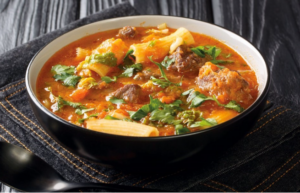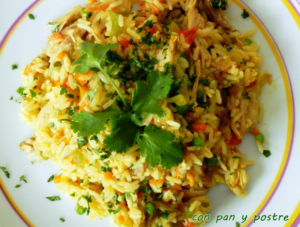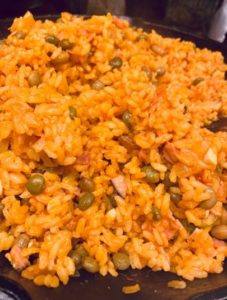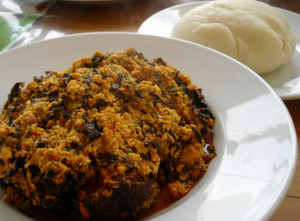The 2025 National Nutrition Month theme is “Food Connects Us.” Food is a connecting factor for many of us. Food connects us to our cultures, our families and our friends. Sharing a meal is an opportunity to learn about its preparation, who made it and where the ingredients were sourced. Health, memories, traditions, seasons and access can all impact our relationship with food. While these factors influence the foods we eat, the foods we eat also affect our health.
Food & Culture
Recently, MCPHD Nutrition Services had the opportunity to interview various MCPHD employees about recipes specific to their own culture and discussed how these foods keep them connected to their traditions, families, and values. We’d like to thank the following MCPHD employees for their participation: Olusegun Ajidabe, CHES, Dorcaste Elian, CHW, Martha Hoffman, MSW, LCSW, and Amanda Santiago, IBCLC.
Watch this webinar to learn more about how Food Connects Us!
Interviews
Name: Olusegun Ajibade, CHES
Role: Community Health Specialist
Nationality/Ethnicity: Nigerian, born and raised.
Nigeria has a lot of diverse cultures, and this brings a variety of dishes that represent the various tribes. My tribe (Yoruba) has numerous recipes that are known to be spicy! You can always adjust the spice level to your preference though. One recipe that is culturally significant to me is Egusi (eg-OO-see) soup. In addition to the deliciousness of this recipe, I enjoy its versatility. This soup is best paired with a swallow (dough-like food made from starchy vegetables and/or grains) of choice, pounded yam is my preferred choice. I also enjoy the memories made while waiting for this recipe to be made as a child. Sunday afternoons were fun, “helping out” in the kitchen.
Egusi (eg-OO-see) Soup. Egusi is a traditional one pot soup made from melon seeds. It’s a Nigerian staple that is flavorful and rich in essential nutrients.
Recipe: https://cheflolaskitchen.com/egusi-soup-recipe/
The traditional method of preparing this recipe can vary. Some items can also be hard to secure. I simply skip some items that I may not have available (locust beans). I’m more mindful of my sodium consumption nowadays, so I add a variety of spices to flavor it while paying attention to the seasoning cubes and salt.
This recipe is a staple that does not need to wait for a special occasion. You will find it at parties or at the dining table any day of the week (late lunch or dinner). Trust me, it is a regular guest in Yoruba homes.
Celebrating cultural food diversity is very important to me because of the connection it creates. Food brings people together, and delicious foods can create lasting memories when shared with others. I think of my vast social network and all the meals and memories we’ve exchanged. It is hard to imagine a life without the beautiful and plenty food cuisines with such rich history. Cultural food diversity helps me appreciate cooking practices that represent our traditions.
Name: Dorcaste Elian
Role/Job title: CHW/Haitian Creole Interpreter
Nationality/Ethnicity: Haitian American
Soup Joumou is significant to me because as early as I can remember I have been able to enjoy this soup. The history behind it was one of the first lessons I would learn about my Haitian heritage. I enjoy what the recipe represents and of course eating it. It is very delicious.

Ingredients:
Epis
- 1 cup chopped scallions (from 5 medium scallions)
- 1/2 cup fresh flat-leaf parsley leaves, chopped
- 1/3 cup chopped green bell pepper
- 1/3 cup chopped red bell pepper
- 1/3 cup chopped yellow bell pepper
- 1/4 cup chopped yellow onion
- 1/2 teaspoon fresh thyme leaves (from 1 to 2 medium sprigs)
- 2 tablespoons olive oil or canola oil
- 6 garlic cloves, chopped, about 2 1/2 tablespoons
Soup
- 2 pounds beef stew meat (mixture of chuck and beef stew meat), cut into 1- to 2-inch pieces
- 1 cup white vinegar
- 1 medium lime, halved
- 1 cup Epis
- 2 tablespoons olive oil
- 1 tablespoon seasoned salt
- 3 tablespoons fresh lime juice (from 2 medium limes), divided
- 5 1/3 cups cubed (1- to 1 1/2-inch pieces) calabaza squash or butternut squash (1 medium)
- 7 cups water, divided, plus more as needed
- 4 1/2 cups cubed (3/4- to 1-inch pieces) peeled russet potatoes (from 2 large potatoes)
- 2 1/2 cups sliced (1/4- to 1/2-inch thick) green cabbage (from 1 [2-lb.] head cabbage)
- 1 1/2 cups halved and sliced (1/4- to 1/2-inch thick) yellow onion (from 1 medium onion)
- 1 1/3 cups finely chopped leek (white and light green parts only) (from 1 medium leek)
- 1 1/3 cups peeled finely chopped turnips (from 2 small turnips)
- 2/3 cup sliced (1/4- to 1/2-inch thick) carrots (from 2 medium carrots)
- 1/2 cup roughly chopped celery (from 1 medium celery stalk)
- 1 (2-inch) fresh green Scotch bonnet chile or habanero chile
- 1 tablespoon kosher salt
- 2 teaspoons garlic powder
- 2 teaspoons onion powder
- 1/2 teaspoon black pepper
- 1/8 teaspoon cayenne pepper
- 6 whole cloves
- 1 (11 3/4-inch) parsley sprig
- 1 (5 1/2-inch) thyme sprig
- 1 cup uncooked dried rigatoni pasta (2 1/2 ounces)
- 1 tablespoon unsalted butter
Directions
Prepare the Epis:
- Process scallions, parsley, bell peppers, onion, thyme, oil, and garlic in a food processor or high-speed blender until smooth and well combined, about 1 minute, stopping to scrape down sides of bowl as needed. Reserve 1 cup Epis for Soup; remaining Epis may be covered and stored in a freezer-safe container in freezer for up to 1 month.
Prepare the Soup:
- Place beef and vinegar in a large bowl. Squeeze lime halves over beef mixture; rub meat with inside of lime halves. Rinse with cold water, and drain; return meat to bowl.
- Add Epis, oil, seasoned salt, and 2 tablespoons of the lime juice to meat in bowl; stir until well coated. Cover and marinate in refrigerator for at least 30 minutes or up to 12 hours.
- When meat is nearly done marinating, fill a 7- to 8-quart pot with water, and bring to a boil over medium; add squash, and cook over medium, stirring occasionally, until squash is fork tender, 10 to 12 minutes.
- Drain cooked squash. Transfer to a food processor or high-speed blender; process until smooth, 1 to 2 minutes, stopping to scrape down sides of bowl as needed. (Add additional water, 1 tablespoon at a time, only if needed to help squash blend.) Set aside.
- Add beef mixture and 2 cups of the water to pot; bring to a boil over medium. Reduce heat to medium-low; cover and simmer, stirring occasionally, until meat is just tender, 1 hour, 30 minutes to 1 hour, 45 minutes, adding up to 1 cup additional water, if needed, to keep meat covered. Adjust heat as needed to maintain a simmer.
- Stir squash puree into beef mixture in pot. Stir in potatoes, cabbage, onion, leek, turnips, carrots, celery, chile, kosher salt, garlic powder, onion powder, black pepper, cayenne pepper, cloves, parsley sprig, thyme sprig, and remaining 5 cups water. Increase heat to medium, and simmer, uncovered and stirring occasionally, until vegetables are just tender, 10 to 15 minutes; adjust heat as needed to maintain a simmer. Add rigatoni, butter, and remaining 1 tablespoon lime juice. Reduce heat to low; simmer, stirring occasionally, until pasta is cooked, 10 to 12 minutes. Adjust thickness of soup as desired, by adding more liquid for a brothier texture, or continuing to simmer it so it thickens.
My personal twist to this recipe would be using pig feet and oxtail as my protein.
This is traditionally prepared for Haitian Independence Day on January 1st.
For someone of Haitian descent like myself, celebrating cultural food diversity allows me to connect with my heritage and allows me to preserve traditional recipes and culinary practices that have been passed down through generations.
Name: Martha Hoffmann, MSW, LCSW
Role: Clinical Social Worker
Nationality/Ethnicity: Colombian
Arroz con pollo (chicken with rice) is culturally significant to me because it reminds me of my mother’s cooking and times with family. I also love the taste and this meal was the only way I could eat vegetables as a child.

Ingredients:
- 2or 3 chicken breasts, cooked and chopped in small pieces.
- 2 Tablespoons avocado oil or other preferred oil
- ½ Red pepper, chopped.
- ½ green pepper, chopped
- 1 garlic clove, crushed.
- 1cups of rice
- 2cups of water
- ½ cup of shredded carrot
- 1/2 -cup of cut celery
- ½ cup of- cilantro
- ½ packet of seasoning with saffron or curcumin
- Salt to taste
Directions:
- In a pot add: 3 cups of water, the chicken breast, fresh garlic and salt, or chicken bouillon, and cook the chicken breast until they are soft and cooked through. After a few minutes shred the chicken.
- In another pot add water 2 cups of water to boil (You can use the water used to cook the chicken) after adding 1 cup of rice already washed, add ½ packet of saffron and salt to taste. cover the pot and cook at low heat for 15 to 20 minutes until the rice is soft/tender.
- Heat oil in a large pan over low heat for 5 minutes. Stir-fry the chopped peppers, celery, shredded carrots, cilantro and garlic, stir everything well, add the shredded chicken and continue stirring for 5 minutes in low heat. Then you add the rice and mix with all the vegetables.
I accompany this food with a banana.
Personally, it was prepared mostly for birthday parties and family reunions.
I think is important because is part of who I am and my identity. Also, celebrating food diversity allows others to learn and understand other people’s feeding habits and their relationship with food.
Name: Amanda M. Santiago Velazquez, IBCLC
Role: WIC Breastfeeding Lead
Nationality/Ethnicity: Puerto Rican/Hispanic
Arroz con Gandules. As I am far from my home country, every time I cook it, it takes me back to those amazing times we shared with family and friends.

Ingredients:
- 1 tablespoon olive oil
- 1/3 cup country ham or bacon, diced (optional)
- 1/3 cup sofrito
- 3 cups water or low sodium chicken broth
- 1 ½ tsp sazón con achiote y culantro
- 1 cube chicken bouillon or more if needed
- 2 tbsp tomato paste or 1/3 cup tomato sauce
- 1 teaspoon dried Italian seasoning or oregano either one works
- 1/4 cup fresh cilantro, chopped optional
- 2-3 bay leaves
- 2 tablespoons pimento stuffed olives optional
- 15 ounce can Pigeon Peas (Gandules), drained and rinsed or 2 cups of fresh or frozen
- 2 cups parboiled rice
Directions:
- Heat your caldero or Dutch oven to medium heat, and add your olive oil, bacon/ham (if using) and sofrito. Stir constantly until fragrant and tender, but not browned, about 4 minutes.
- Next add in the Sazon, tomato sauce or paste and chicken bouillon. Stir to combine.
- Add in the drained pigeon peas, Italian seasoning or oregano, bay leaves, and water/broth. Add the cilantro and/or olives, if using. Allow the liquid to come up to a boil and taste it for salt. If it needs more saltiness, add in another chicken bouillon cube. You want this liquid to be highly seasoned, as it will determine the final seasoning of the rice.
- Once the mixture is boiling, add the rice. Stir the rice to get it submerged and distribute the pigeon peas throughout.
- Cover and allow the rice to absorb all the visible liquid. Once most of the visible surface liquid is absorbed, stir the rice, and cover again. Lower the flame to low and allow it to steam for 20-25 minutes. It’s done with all the liquid is absorbed and the grains are fluffy and fully cooked.
Arroz con Gandules is a cultural dish in Puerto Rico; we cook it any time of the year, but at Christmas time, it is the protagonist of each party or reunion.
I grew up helping my mom or grandma cook it, we also get the peas from the plant.
Celebrating food diversity is important because we can share with the world one piece or taste of our culture
This month, Nutrition services would like to task you with taking time to explore opportunities for more connection in your own food environment.
In honor of National Nutrition Month, the Nutrition Services Team would like to remind you that we are here to help! If you would like to meet with a dietitian for some guidance or to ask specific questions, give us a call at 317-221-7403.








